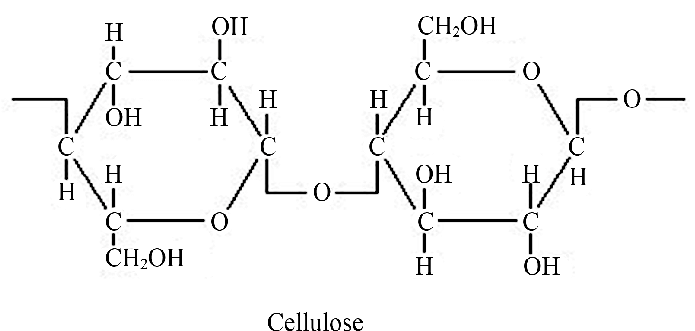
Cellulose is made of
(a) Unbranched chain of glucose molecules linked by α – 1,6 glycosidic bonds
(b) Unbranched chain of glucose molecules linked by β – 1,4 glycosidic bonds
(c) Branched-chain of glucose molecules having α – 1,6 glycosidic bonds at the site of branching
(d) Branched-chain of glucose molecules with α – 1,6 glycosidic bonds in the straight-chain and β – 1,4 linked bonds at the site of branching
Answer
573k+ views
Hint: Cellulose, a structural carbohydrate is a linear homopolymer formed from repeating units of D-glucose, present in the beta conformation linked by glycosidic bonds. It is an abundant carbohydrate.
Complete answer:
The cellulose molecule is a linear, unbranched homopolysaccharide, consisting of 10,000 to 15,000 D-glucose units in β configuration linked by (β-1,4) glycosidic bonds.

Cellulose is a fibrous, tough, water-insoluble substance. It is present in the cell walls of plants, specially in stalks, stems, trunks, and all the woody portions of the plant body. Much of the mass of wood is from Cellulose.
Most animals are incapable to use cellulose as a fuel source, because they lack an enzyme to hydrolyze the β-1,4 linkages. In the animal kingdom, Termites are known to readily digest cellulose (and therefore wood) , because their intestinal tract harbors Trichonympha, a symbiotic microorganism that secretes cellulase, which hydrolyzes the β-1,4 linkages. Wood-rot fungi and bacteria can produce cellulase.
So, the correct answer is ‘Unbranched chain of glucose molecules linked by β-1,4 glycosidic bonds’.
Note:
- Cellulose is the primary structural carbohydrate in plants.
- Cellulose is indigestible by human beings.
- Cellulose is used in the paper industry and the textile industry.
- Cotton is almost pure cellulose.
Complete answer:
The cellulose molecule is a linear, unbranched homopolysaccharide, consisting of 10,000 to 15,000 D-glucose units in β configuration linked by (β-1,4) glycosidic bonds.

Cellulose is a fibrous, tough, water-insoluble substance. It is present in the cell walls of plants, specially in stalks, stems, trunks, and all the woody portions of the plant body. Much of the mass of wood is from Cellulose.
Most animals are incapable to use cellulose as a fuel source, because they lack an enzyme to hydrolyze the β-1,4 linkages. In the animal kingdom, Termites are known to readily digest cellulose (and therefore wood) , because their intestinal tract harbors Trichonympha, a symbiotic microorganism that secretes cellulase, which hydrolyzes the β-1,4 linkages. Wood-rot fungi and bacteria can produce cellulase.
So, the correct answer is ‘Unbranched chain of glucose molecules linked by β-1,4 glycosidic bonds’.
Note:
- Cellulose is the primary structural carbohydrate in plants.
- Cellulose is indigestible by human beings.
- Cellulose is used in the paper industry and the textile industry.
- Cotton is almost pure cellulose.
Recently Updated Pages
Master Class 12 Business Studies: Engaging Questions & Answers for Success

Master Class 12 Economics: Engaging Questions & Answers for Success

Master Class 12 English: Engaging Questions & Answers for Success

Master Class 12 Maths: Engaging Questions & Answers for Success

Master Class 12 Social Science: Engaging Questions & Answers for Success

Master Class 12 Chemistry: Engaging Questions & Answers for Success

Trending doubts
What is meant by exothermic and endothermic reactions class 11 chemistry CBSE

Which animal has three hearts class 11 biology CBSE

10 examples of friction in our daily life

One Metric ton is equal to kg A 10000 B 1000 C 100 class 11 physics CBSE

1 Quintal is equal to a 110 kg b 10 kg c 100kg d 1000 class 11 physics CBSE

Difference Between Prokaryotic Cells and Eukaryotic Cells




